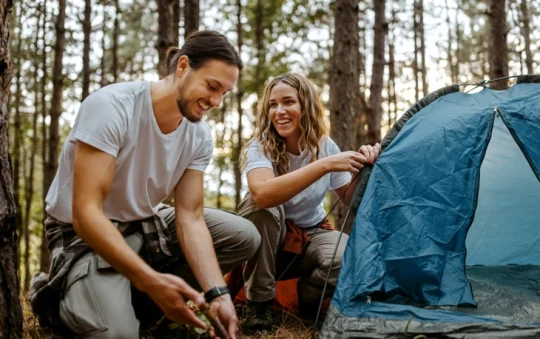Starting out on the thrilling adventure of backpacking opens up a whole new world of breathtaking natural wonders. Beyond the captivating landscapes and meandering trails lies a set of essential skills that are absolutely crucial for every backpacker.
This comprehensive guidebook delves into the fundamental basics that lay the foundation for successful backpacking expeditions. These skills serve as the guiding light, leading adventurers through unfamiliar territories, providing a safe haven from the elements, and ensuring they have the sustenance they need for their journey. Whether you’re a seasoned hiker or a beginner to the trails, mastering these skills is absolutely essential for your safety and to enhance your outdoor experiences.
Throughout this incredible journey, we will explore vital navigation techniques, delve into the art of setting up campsites and shelters, reveal strategies for managing supplies and staying hydrated, and prioritize safety and emergency preparedness. By embracing these fundamental principles, you will be able to embark on backpacking adventures with confidence, forging a deeper connection with the wilderness with every step you take.
Let’s begin this exciting journey together and embrace the wonders of the great outdoors!
Navigation Skills
Having effective navigation skills is crucial for a successful backpacking adventure. It allows you to confidently explore different terrains and reach your desired destinations. Whether you’re trekking through remote trails or venturing into unexplored wilderness areas, honing these skills is essential for your safety and peace of mind.
Understanding Maps:
Being able to interpret topographic maps is a fundamental skill for all backpackers. These maps provide important information about the landscape, including changes in elevation, water sources, and notable landmarks. By understanding contour lines, symbols, and scale, you can accurately measure distances and plan your route effectively.
Using a Compass:
Despite the availability of GPS technology, a reliable compass is still indispensable for wilderness navigation, especially in areas with limited satellite reception. Familiarize yourself with basic compass navigation techniques, such as taking bearings, orienting the map, and integrating the compass with map features.
Leveraging GPS Technology:
GPS devices are incredibly useful for navigating challenging terrains. Make sure you understand how to use your GPS device, including setting waypoints, tracking routes, and utilizing breadcrumb trails to retrace your steps. However, always carry a paper map and compass as backups in case of device malfunction or battery depletion.
Orientation:
Before starting your hike, take the time to familiarize yourself with your surroundings. Identify prominent landmarks, determine the orientation of key features like rivers or mountain ranges, and mentally map out the area. Pay attention to trail signage, junctions, and natural cues to stay on course during your hike.
Preparation:
Preparation is key when it comes to a successful backpacking expedition. It’s important to do thorough research on your route, taking into account trail conditions, potential hazards, and where you can find water sources. It’s also a good idea to have backup plans in case anything goes wrong, and make sure to let someone know your itinerary before you start your journey.
By honing your navigation skills and practicing regularly, you’ll gain the confidence to explore new trails and wilderness areas safely. Remember, navigation isn’t just about finding your way, it’s also about enjoying the journey and fully immersing yourself in the beauty of nature.
Setting Up Shelter and Campsites for Backpacking
Choosing the perfect campsite and setting up shelter are essential skills for backpackers. A well-chosen campsite not only offers comfort and protection from the elements but also helps minimize environmental impact. Here are some key factors to keep in mind when arranging your campsite and shelter:
Selecting the Campsite:
Look for a flat, well-drained area, avoiding any potential hazards like dead trees or rough terrain. Consider the proximity to water sources, prevailing winds, and sunlight exposure. Whenever possible, stick to established campsites to follow Leave No Trace principles and reduce environmental harm.
Types of Shelters:
Backpackers have various options to choose from, such as tents, hammocks, tarps, or bivy sacks. Each type has its own pros and cons based on weight, weather conditions, and personal preference. Practice setting up your chosen shelter beforehand for quick assembly in the field.
Setting Up Your Shelter:
Make sure to set up your shelter correctly for comfort and protection. Follow the manufacturer’s instructions for tents, secure them tightly, and stake them down. For hammocks or tarps, consider factors like angle and tree spacing for stability.
Organizing the Campsite:
Maintain order in your campsite to improve efficiency and minimize impact. Designate specific areas for cooking, dining, resting, and storing gear. Use bear-proof containers to hang food and remove all waste before leaving.
Leave No Trace Principles:
Follow Leave No Trace principles to protect wilderness areas. Dispose of waste properly, minimize campfire impacts, and respect wildlife. Leave the campsite cleaner than you found it to ensure it remains enjoyable for others.
By mastering the setup of your shelter and campsite, you can ensure a safe and enjoyable backpacking experience. Prioritize environmental stewardship to preserve wilderness areas for future generations.
Food and Water Management

Properly managing sustenance and hydration is essential for maintaining energy, hydration, and overall well-being while backpacking. Knowing how to obtain, treat, and safeguard these vital resources ensures a safe and enjoyable outdoor experience. Here are key tips for handling food and water:
Sustaining Hydration:
It’s crucial to stay adequately hydrated, especially in hot and dry conditions. Carry sufficient water or locate reliable sources along your path. Plan your water intake wisely to stay hydrated all day, considering factors like activity level, temperature, and humidity.
Water Purification:
Treating water from natural sources is necessary to avoid waterborne diseases. Portable filtration systems, chemical tablets, or UV light devices can effectively purify water in the wilderness. Always follow the manufacturer’s instructions for safe water treatment.
Meal Preparation:
Plan your meals carefully to ensure you have enough nutrition and energy for your backpacking trips. Opt for lightweight, non-perishable foods rich in calories and nutrients, like dehydrated meals, nuts, dried fruits, and energy bars. Consider factors such as weight, size, and preparation time when choosing food for your journey.
Food Storage:
Properly storing food is essential to prevent wildlife encounters and minimize environmental impact. Use bear-resistant containers or hang food and scented items securely, especially in bear-prone areas. Keep food and waste away from your campsite to deter wildlife and avoid conflicts.
Waste Management:
Adhere to Leave No Trace principles by reducing food waste and disposing of scraps and packaging responsibly. Carry out all trash, including wrappers and peels, to leave your campsite clean. Avoid burying or burning food waste to prevent attracting wildlife and disrupting ecosystems.
By focusing on effective food and water management, you’ll have the energy and hydration needed for a safe and sustainable backpacking adventure.
Safety and Emergency Preparedness
Ensuring the safety and preparedness for emergencies is absolutely essential for every backpacker. It equips them to effectively handle potential risks and unexpected challenges that may arise in the wilderness. By acquiring the necessary knowledge, honing their skills, and obtaining suitable gear, backpackers can minimize risks and embark on outdoor adventures with confidence. Here are some fundamental principles to prioritize safety and emergency preparedness:
First Aid Kit:
Always carry a comprehensive first aid kit that includes all the essentials for treating common injuries and medical emergencies that you may encounter while backpacking. Items like bandages, adhesive tape, antiseptic wipes, pain relievers, and blister treatments are crucial for addressing minor health concerns.
Emergency Shelter:
Make sure to include a lightweight emergency shelter, such as a space blanket, bivy sack, or compact tent, in your gear. This will provide you with refuge from harsh weather conditions or unexpected overnight stays outdoors. When choosing an emergency shelter, consider factors like durability, weather resistance, and ease of setup.
Communication Devices:
Bring along communication tools like a cell phone, satellite phone, two-way radio, or personal locator beacon (PLB) to call for help in case of emergencies. It’s important to ensure that these devices are fully charged and have reliable signal coverage for the hiking area you’ll be exploring.
Navigation Tools:
Carry reliable navigation instruments such as a map, compass, or GPS device to assist you in navigating through unfamiliar terrain. Familiarize yourself with basic navigation techniques, including map reading, compass navigation, and GPS usage, so that you can confidently traverse diverse landscapes.
Emergency Protocol:
Develop an emergency protocol that outlines the steps to take in various emergency scenarios, such as injuries, getting lost, or encountering severe weather. Before your trip, share your itinerary and emergency protocol with a trusted individual, and establish a schedule for regular check-ins. This will ensure that someone is aware of your plans and can assist if needed.
Leave No Trace:
Remember to follow the Leave No Trace principles to reduce your impact on the environment and protect natural areas for future generations. Make sure to keep your campsite tidy, take all your trash and waste with you, and be mindful of wildlife and delicate habitats.
Stay well-informed, be prepared, and take proactive steps to guarantee a safe and delightful outdoor experience.
In Conclusion
May your backpacking adventures be filled with awe-inspiring moments and unforgettable experiences as you master essential skills. Proficiency in navigation will empower you to confidently explore diverse terrains and reach your destinations smoothly. By skillfully setting up shelters and campsites, you can find comfort and protection amidst the elements. Managing your food and water resources adeptly will ensure sustained energy throughout your journey. Remember to prioritize safety and preparedness, equipping yourself to handle any unforeseen challenges with ease.
It is crucial to adhere firmly to Leave No Trace principles, meticulously removing waste and leaving campsites undisturbed to reduce ecological impact. Approach each adventure with a blend of curiosity, humility, and deep reverence for the wonders of nature, whether you embark on short excursions or lengthy treks. Every step you take in the wilderness offers opportunities for personal growth, exploration, and a profound connection with the natural world.
As you venture into the great outdoors, find tranquility in the rhythm of your footsteps, draw inspiration from the beauty that surrounds you, and discover fulfillment in overcoming obstacles. With these essential skills at your disposal, may your backpacking experiences be filled with lasting memories and a profound appreciation for nature’s transformative power.
Make sure to include efficient cooking equipment in your backpacking gear for easy meal preparation along the trail. Approach your journeys with a spirit of inquiry, humility, and wonder for the magnificence of the natural world. Wishing you safe travels, and may your adventures reflect the endless possibilities that lie ahead.





